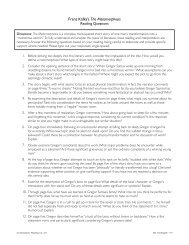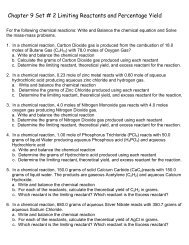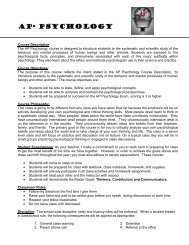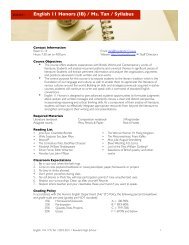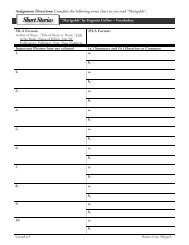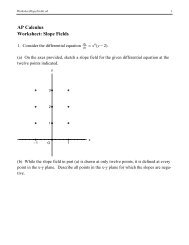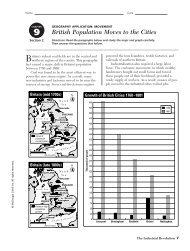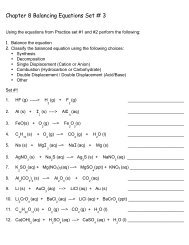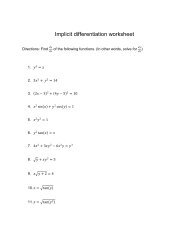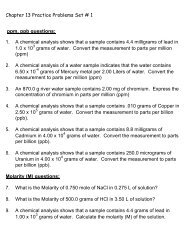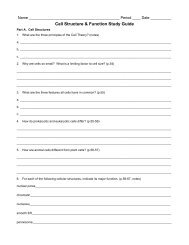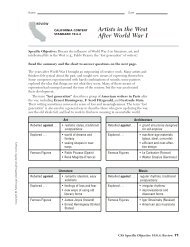Chem Semester _2 Study Guide 2010 Multiple Choice pdf
Chem Semester _2 Study Guide 2010 Multiple Choice pdf
Chem Semester _2 Study Guide 2010 Multiple Choice pdf
You also want an ePaper? Increase the reach of your titles
YUMPU automatically turns print PDFs into web optimized ePapers that Google loves.
<strong>Chem</strong>istry Sem #2 <strong>Study</strong> <strong>Guide</strong>The Mole• Conversion Factors• Factor-Label Method• Scientific Notation• Significant Digits• Atomic Mass Units• Molecular Mass vs. Formula Mass• Molar Mass• Avogadro’s Constant (6.02 X 10 23 "Items")• The Mole• The Mole and Gram Atomic Mass• The Mole and Avogadro's Constant• Percentage Composition• Empirical Formulas• Hydrates (Salt * ____H2O)<strong>Chem</strong>ical Reactions• Products / Reactants• Symbols: (s), (l), (g) and (aq)• Coefficients, Subscripts, Superscripts• Balancing equations• Types of Reactions:• Single displacement• Double displacement• Synthesis• Decomposition• Combustion• Mass-Mass (Stoichiometry) Equations• Percent Yield Equations<strong>Chem</strong>ical Bonding• Ionic bonds• Covalent bonds• Molecular fingerprints• Internuclear distance• Ionic radii• Covalent radii• Delocalized electrons• Electronegativity• Polyatomic IonsKinetic Energy• Potential Energy (PE) PE = Stored Energy• Kinetic Energy (KE) KE = 1/2 mv2• Pressure units (Kilopascals, mm Hg, atm, PSI)• Manometers (Open / Closed)• Kinetic Energy and Temperature• States of MatterLiquids• Vapor or a Gas• Vapor Pressure• Equilibrium• dynamic• static• saturated• reversible change• Entropy or Disorder• Phase Changes• melting point /freezing point• boiling point / condensation point• sublimation point• "Normal Boiling or Melting Point• Volatile substances / Intermolecular forces• Liquefaction• Phase diagrams• Energy and Change of State:• enthalpy of fusion (!H fus)• enthalpy of vaporization (!H vap)• Hydrogen BondingSolutions• Solute / Solvent• Saturated, unsaturated, supersaturated• Dissociation / Ionization• parts per million (ppm)• parts per billion (ppb)• molarity (M) moles/liter• Collegative PropertiesReaction RateReaction Rate:nature of reactants / concentrationtemperature, catalysis / inhibitors
Gases• Ideal Gas• Variables:• pressure (P)• volume (V)• temperature (T)• STP• Boyle’s Law• Charles’ Law• Dalton’s Law• Graham’s Law:• diffusion /effusion• Pressure conversions• Gas Density (grams / mole)• Real Gas / Ideal Gas• Ideal Gas Equation / CalculationsPV = nRTpressure (P) kPavolume (V) Literstemperature (T) Kelvinnumber of moles (n) molesrate constant (R) 8.31L . KPamol . KPV = mRTMpressure (P) kPavolume (V) Literstemperature (T) Kelvinmass of the gas (m) gramsrate constant (R) 8.31L . kPamol . Kgram atomic mass (M) grams / moleMass / Gas Stoichiometry Equations:Mass-Volume CalculationsVolume-Mass CalculationsVolume-Volume CalculationsLimiting Reactants CalculationsAcids, Bases and SaltsTwo theories about acids and bases:ArrheniusAcid / BaseBronsted-LowryAcid + BaseConjugate Acid + Conjugate BaseHydronium [H3O + ] / Hydroxide [OH - ]• Acidic and basic anhydrides• Amphoteric• Strong Weak Acids & BasesTitrations• Neutralization reactions• Net Ionic Equations (rules)• Salts are formedNaming Acids:• Binary, Ternary, Organic,• Monoprotic, PolyproticKw = [H3O + ] [OH - ] = 1.00 X 10 -14pH Scale: 0-14, Neutral = 7pH = - log [H3O + ][H3O + ] = Antilog (-pH)pOH = - log [OH - ][OH - ] =Antilog (-pOH)pKw = pH + pOH = 14Titration: MaVa = MbVb• Standard Solution / IndicatorsHydrolysis / BuffersK a= [H 3 O + ][A − ][HA]= ConstantEquilibriumKeq = [Products] / [Reactants] = "A Constant"Le Chatelier's PrincipleEquilibrium shiftStressTemperaturePercent of Ionization / Common Ion EffectKsp = [Metal + ] [Anion - ] = "A Constant"Percent of Ionization / Common Ion Effect€



